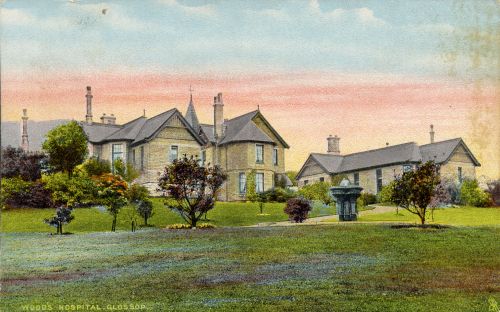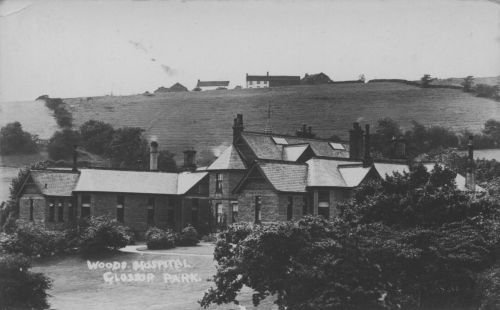A Brief History of Woods' Hospital.
This article was based on contemporary newspaper reports
At the meeting of the Council's General Purposes Committee on 20 October 1886, Councillor Herbert Rhodes (see The Rhodes family of Tintwistle and Mersey Bank) offered the Corporation a sum of £2,000 as a nucleus for the provision of swimming baths or a public hall and free library in celebration of Queen Victoria's Jubilee. A sub-committee was formed to take the proposal forward.
When the sub-committee met, on 4 November 1886, Alderman Stafford reported that Mr. Daniel Wood of Moorfield House (see Wood and Hill-Wood families) had written to him expressing his intention to give a hospital to the town.
Alderman James Sidebottom (see Sidebottoms of Hollingworth) said he had seen Daniel Wood that afternoon, who told him he was prepared to build an hospital at a cost of £5,000, and endow it with a further sum of £20,000, so that the poor hereafter might have the benefit of it, a total of £25,000 altogether. Daniel Wood had been thinking of endowing a hospital for some time and it had been mentioned in his will. His original intention was that it should he built after his death, but acting upon the advice of his friends, he had decided to make the offer now so that the building might be completed during his lifetime. Daniel Wood had said that he should leave the working of the hospital and the choosing of the staff entirely in the hands of the Town Council; the only connection he wished to have with the institution was that it should be called “The Woods' Hospital”.
Alderman Sidebottom also reported that Mr. Samuel Wood of Talbot House (brother of Daniel), and his wife Anne Kershaw Wood (a sister of Alderman Sidebottom) had stated that they would erect baths for the town providing arrangements could be made for a site and for water. Alderman Sidebottom proposed that the offers be considered together with the offer from Councillor Rhodes, so that there would not be two movements in the town for carrying out similar objects.
Major William Sidebottom M.P. (brother of James) suggested that Lord Howard should be asked if he would provide land for a site for the hospital and baths as a free gift, and also for a supply of water for the baths without affecting the town's existing water supply.
Once that was agreed, Councillor Garside proposed that, as there was separate funding for a hospital and baths, Councillor Rhodes' offer of £2,000 should be devoted towards providing a free library and a public hall, together with necessary supplementary funding. Councillor then offered to match Councillor Rhodes' offer and give £2,000 towards the erection of a free library and public hall.
The foundation stone of the hospital was laid by Alderman James Sidebottom on 30 July 1887, the same day that the foundation stones of Woods' Baths and the Victoria Hall were laid, all with great ceremony. Howard Park was not opened to the public until 16 June 1888.

The hospital opened on Monday 21 January 1889, the Glossop-dale Chronicle and North Derbyshire Reporter of 26 January reporting the event as follows:
The splendid hospital, built and endowed by the generous gift of £25,000 by the late Mr. D. Wood was opened (without ceremony) for the reception of patients on Monday. Supplementary to the chief gift, Mrs J. Wood has kindly paid the cost of furnishing, and Mr. J. Rowcliffe, of Gamesley, has provided the beds. A repetition of the general arrangements of the building will not now be out of place.
The hospital is to the north-western corner, on high, but not the highest ground, facing south-east and well sheltered from the north and easterly winds. It would be difficult to find a more favoured spot in the neighbourhood of Glossop for such an establishment, and thankful indeed should those be who seek convalescence within its walls,to the generous donor of the building and of the liberal endowment. From its elevated position and its sunny terrace, the eye roams with pleasure over the far-stretching outlines of the moors and hills, which embrace the western, southern and eastern sides of the Glossop valley. The accommodation provided is not for a large number of patients, but is of the best possible quality, and brought up to the greatest pitch of perfection which recent sanitary authorities have laid down as essential to hospital construction. The main building is planned somewhat like the letter E, the short central line containing the administrative portion, and the two longer ones the male and female wards respectively, whilst the upright line represents the connecting corridor. In the administrative block will be found the matron's apartments and those of the domestic servants and off-duty nurses' rooms, together with surgeons' room, kitchen, scullery, dispensary and an excellently lighted operating-room, linen and store-rooms &c. The wards provide accommodation, in each wing, of one room 40ft. by 24ft. and 13½ft. high, to hold a minimum of six beds, thus affording nearly 2,300 cubic feet per patient. On one side of each ward is a comfortable ingle nook, with fireplace and, at the end, isolated from the ward by a ventilating passage, the lavatories, bath, &c. In addition there is in each wing a separate room, 21ft. by 20ft., for two special beds and a nurses' kitchen, scullery, &c. There is thus accommodation, on a very liberal scale indeed, for at least 16 patients. The wards are separated from the administrative block by short corridors, lighted and cross-ventilated by windows on each side.
The wards are only one storey high, they have windows on each side for “through” ventilation and are raised up so as to be about 4ft. clear of the ground. The floors are of cement concrete, carried on iron girders, and finished with solid wood-block flooring. Ventilating openings in the walls below the floor level will allow a free sweep of air under them and effectively prevent any damp or miasmatic exhalations rising from the ground into the wards. All the internal surfaces of the walls are lined for some height with glazed brick, while the external walls are made impervious to wet by a sheet of asphalte being fronted in between the outer and inner faces. To the west of the hospital is a detached boiler-house, washhouse, laundry and lodge-keepers' house, also a stable and coachhouse for the use of the medical practitioners.
The whole of the buildings are faced with stone and slated with greenish-coloured slate. Messrs. Robert Neill and Sons, of Manchester, are the contractors for these buildings.
Mrs J. Wood mentioned in the report was Emma Wood, widow of John, the brother of Daniel and Samuel, and sister of Anne Kershaw Wood.

The original endowment was not the only funding by the Wood family. In September 1889 John Wood of Whitfield House (son of John and Emma) gave £1,000 as he did not wish ratepayers to have to bear the cost of funding still required. At a meeting of the Town Council on 7 January 1891, Alderman James Sidebottom reported that John Wood had further pledged £100 per annum to maintain two beds and Anne Kershaw Wood had pledged £50 per annum to maintain a third bed.
The Wood family were not the only benefactors by any means, a few examples being as follows:
The Council accounts presented in July 1891 showed that James Sidebottom, who was chairman of the hospital committee, had gifted £100.
Cephas Ernill of Pikes Lane, who died in July 1903, left £1,000 in his will for the purchase of a cot with the remainder to be invested for the benefit of the hospital.
James Beeley of Derbyshire Level, who died in April 1931, left a quarter of his residual estate (after a number of specific bequests) to the hospital.
Edward Wagstaffe Allen, Chairman & Managing Director of Olive & Partington, who died in February 1933, left £100 to Glossop Corporation for the benefit of the hospital.
The Jackson Trust funded, amongst other things, the building and equipping of the operating theatre.
On the formation of the National Health Service in July 1948, Woods' Hospital came under the control of the Manchester Regional Hospital Board.
The Manchester Evening News of 24 May 1949 reported that the Manchester Regional Hospital Board had decided that Woods' Hospital was to be closed to surgical cases in spite of local opposition. Surgical beds for Glossop cases would be allocated at Ashton Infirmary. Woods' Hospital became a convalescent home for patients to recover after long stays in Ashton Hospital.
The hospital was threatened with closure in the 1960s and 1980s but survived after vigorous local campaigning. It did close in 1999, but only for a £758,000 face lift. It was officially re-opened on 15 January 2001 (about three months after patients had returned) as a community-based hospital providing a comprehensive service for older people with mental health problems. Mainly aimed at people living in Glossop and Longdendale, it had facilities for in-patients and a day hospital.
The hospital finally closed in 2009 and was sold in 2014, becoming the home of the Reuben's Retreat charity.
Return to GJH.me Home Page, Return to Glossop Area Local Histories index.
Last updated: 20 July 2022


